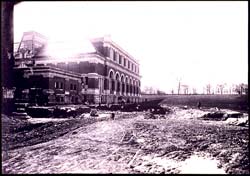 |
 |
 |
| Lecture 2 Medievalism: |
|
Incorporated in 1870, the Metropolitan Museum of Art was at its inception a largely Protestant vision: a repository of art was to provide a suitable counterpart to church in catering to the needs of a public with more leisure time on its hands than ever before. Darn it, New Yorkers deserved, and indeed needed, to see Old Masterworks without leaving the isle of Manhattan! In all seriousness, the creation of a collection of artworks, both real and facsimile, was driven in part by a moral imperative in which objects of the past vouchsafed a renewal of virtues associated with that past. For many of the movers and shakers of fin-de-siecle New York, the art of the Middle Ages epitomized such a paradigm; poised at the dawn of a new century, amid a socio-cultural landscape percolating with rapid artistic and technological change, America's nobility of robber barons and financiers developed a predilection for things medieval. As Michael Camille [The Gothic Idol: Ideology and Image-Making in Medieval Art (Cambridge, 1989), p.350] has suggested, the Middle Ages are so often represented as a (unified!) period "when people not only understood their place in the world but had access to symbols and signs that granted them access to the world to come"; in the treasure troves of the Middle Ages, the collectors whose tastes formed the permanent collections of the greatest American museums found solace from the rapidly changing modern world. America, or at least the Metropolitan Museum of Art, would face modernity armed with an arsenal of artifacts from the past. The medieval past especially provided a field ripe for the sowing of typologies of the rich and famous. Europe's cash-poor and dispossessed nobility ceded to the great American aristocrats. It is difficult not to imagine the titan John Pierpont Morgan (1837-1913) smiling as he purchased wholesale some of the oldest and most prized art collections in all Europe, and brought them home to his "modest" Murray Hill brownstone. The tale of J. P. Morgan and the tale of Medieval at the Metropolitan are inextricable. Morgan joined the board of the inchoate museum in 1888 and remained the most powerful man on it until his death in 1913, and his tenure at the Met coincided with his ravenous appetite for medieval artworks.
Hundreds of objects from Morgan's collection went on display at the Met in 1908 and the New York Times, who had been reticent with respect to, if not critical of the Museum, touted the exhibit as the most important ever held in the city. For the first time, an American public of scholars and museum-goers had access to sundry medieval objects--from Early Christian to Late Gothic. Morgan's larger-than-life persona drew the public to see the works: they weren't just seeing works of the European Middle Ages for the first time, but they were seeing objects owned by a man wealthy enough to have bailed out the US government--twice. The Morgan bequest (look for it: Accession numbers 17.190 ... ) indeed was fundamental to bringing the Met and other American museums into the 20th century. That is, before Morgan, much of the focus of the American art museum was the facsimile: plaster casts of everything from small ivories to church facades. In his wake, the Metropolitan's collecting of medieval art, which continued apace, necessitated, in 1933, the creation of the Medieval Department out of the general moniker of "decorative arts", and thereby gained a sense of quality and authenticity. In short, the museum was brought out of the dark ages as a space for "curiosities" and into the modern world making unique and remarkable objects available to a larger public than ever before. |


